Brisbane property market update June 2024
Brisbane property prices continue to climb as the first six months of 2024 draw to a close. With Brisbane remaining one of the top three fastest growth locations over the last 12 months, there is a clear divergence between capital city market performances across the country.
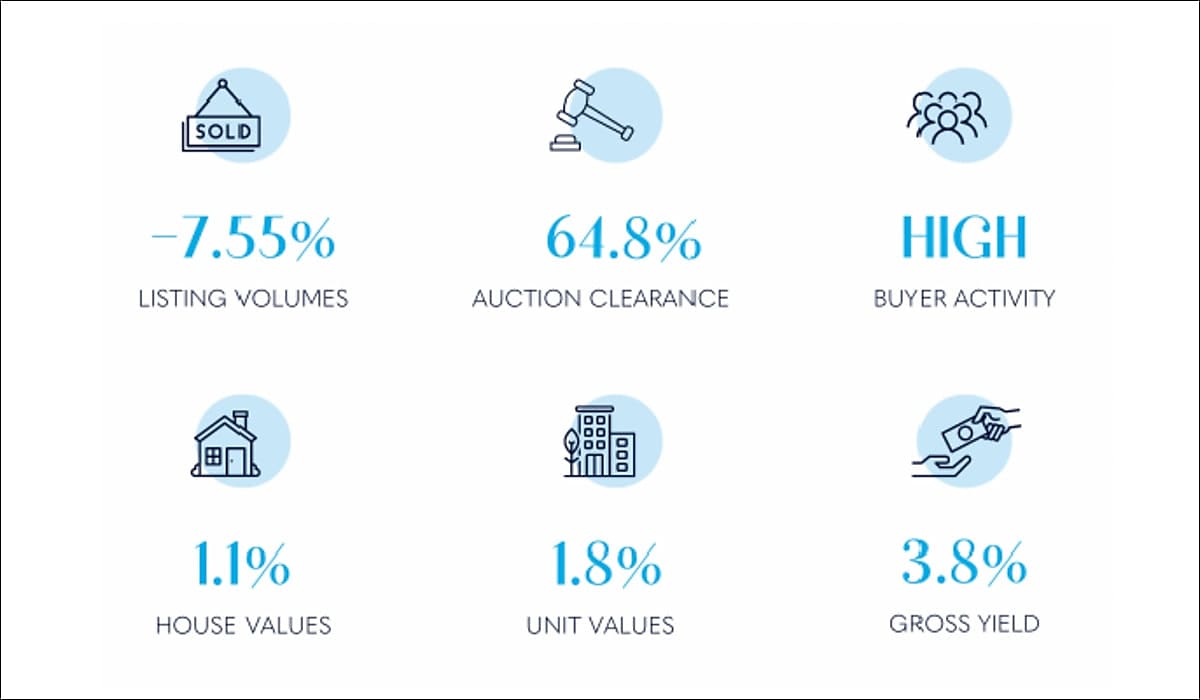
Perth, Adelaide, and Brisbane have consistently been the strongest-performing markets since the pandemic began. These smaller capital city markets show a clear difference in performance compared to others across the country. The graph below illustrates the cumulative changes in performance among capital city markets from the start of the pandemic through the end of May 2024.
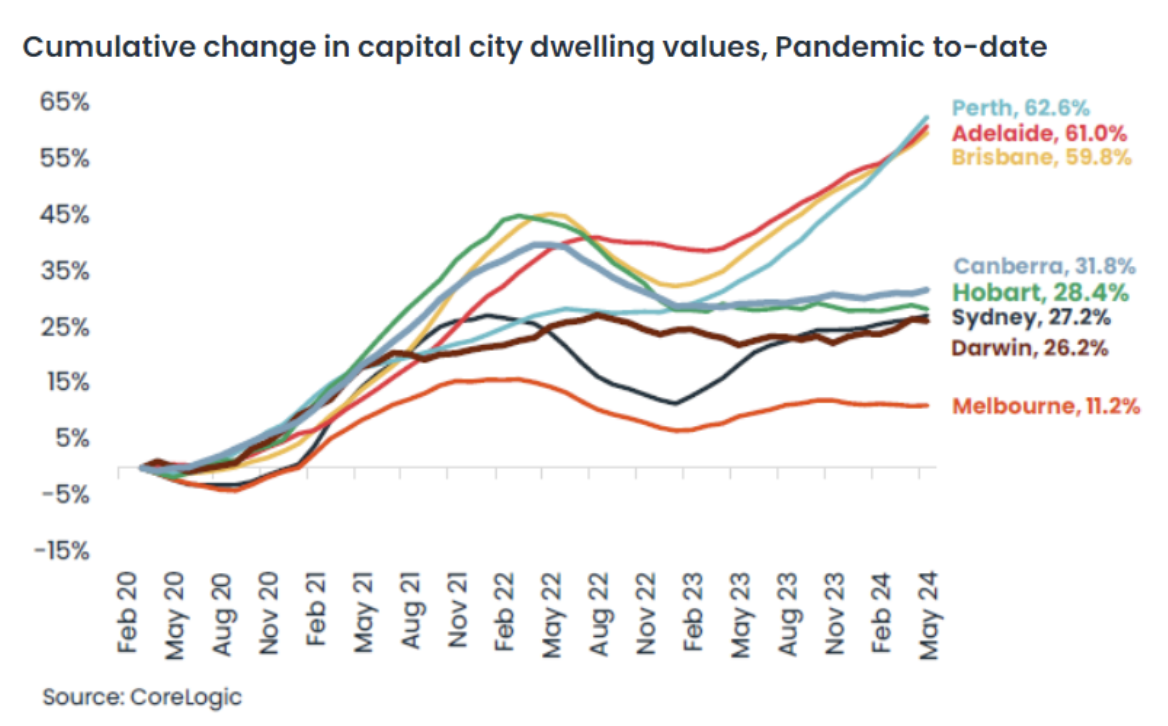
Including data up to the end of June, Perth has experienced the largest increase in home values since the start of the pandemic in March 2020, rising by 66.6 per cent. Adelaide follows closely with a 63.9 per cent increase, and Brisbane with a 61.5 per cent increase. In contrast, Sydney’s growth during the same period has been 28.2 per cent, Melbourne’s 11.2 per cent, Hobart’s 28.1 per cent, Darwin’s 25.7 per cent, and Canberra’s 32.2 per cent.
Considering long-term growth over the past decade, Brisbane remains one of the top-performing capital city markets in Australia. This strong performance, both short- and long-term, along with the opportunities arising from current fundamentals, is likely driving increased investment interest in Brisbane as the 2032 Olympic Games approaches.
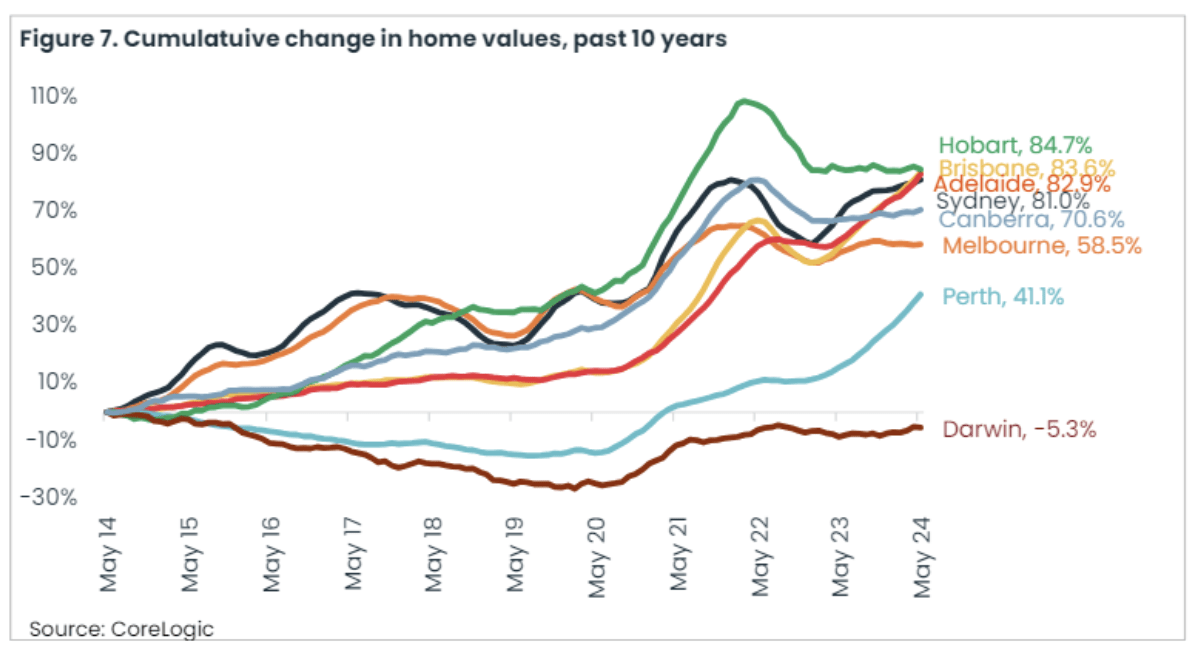
The variations in growth rates between Australia’s capital cities can be explained by the number of home purchases (demand) compared to the number of homes available for sale (supply). This aligns with the classic principle of “supply and demand”.
To demonstrate this relationship, the “sales to new listings ratio” can be calculated by dividing the number of sales over a given period by the number of new listings added to the market.
A ratio of one indicates a balance between buyer demand and available supply, meaning there is one purchase for every property listed for sale. A ratio greater than one suggests strong selling conditions, as there are more transactions than new listings. Conversely, a ratio of less than one indicates a weaker market, with more properties listed for sale than are being purchased.
The graph below shows the sales to new listings ratio for the 12 months to May 2024 across the state capitals, along with the number of sales and listings. This data confirms that stronger markets, including Adelaide, Brisbane, and Perth (and to some extent Sydney), have a sales to new listings ratio greater than one. In contrast, markets like Melbourne and Hobart, where the ratio is less than one, have experienced weaker performance.

This can also be illustrated by comparing the total volume of new listings over the last 12 months, versus the volume of sales within each market.

In Brisbane, supply has been a persistent issue for several years, and it doesn’t seem to be getting better. According to CoreLogic, in the four weeks ending in June, the number of homes advertised for sale in Brisbane was 34 per cent below the five-year average. Meanwhile, interstate migration rates in Queensland remain well above average, sustaining high demand.
The strong growth in property values and rising rents have drawn investors back to the market, with new lending to investors in Queensland reaching record highs. Data from PropTrack shows that 27 per cent of enquiries for Queensland properties come from interstate buyers. This aligns with our observations that many inquiries for purchasing Brisbane properties are from interstate buyers seeking the professional assistance of locally based buyer’s agents.
However, property demand isn’t solely driven by interstate buyers. This month, the Queensland government announced an increase in the stamp duty concession threshold for first home buyers, raising it from $500,000 to $700,000.
The previous $500,000 threshold had become outdated, making the concession largely ineffective due to the substantial rise in Brisbane property prices. The higher price cap now extends eligibility to more homes, offering first home buyers greater options. However, this change could also contribute to increased demand for properties that fall within the new criteria.
These changes are expected to have the greatest impact in areas where median prices are near the caps. With the current median house price in Greater Brisbane at $953,028 and for units at $622,567, the effects may vary across different types of properties.
The new $700,000 threshold means only 20 per cent of houses in Brisbane fall within the new price caps. Therefore, first home buyers will predominantly focus on apartments, as 60 per cent of units in Brisbane are eligible under the new caps.
This disparity is more pronounced in many city areas. For instance, in Capalaba, 84 per cent of units would be eligible under the new cap compared to just 1 per cent of houses. Similarly, in Sandgate, 78 per cent of units meet the new caps, while only 4 per cent of houses do.
In more affordable outer regions, there is a more balanced distribution. For example, in Ipswich Inner, 84 per cent of units and 63 per cent of houses would be eligible under the new caps, while in Caboolture 94 per cent of units and 55 per cent of houses would be eligible.
Even with the increased stamp duty concession threshold, many first home buyers will likely need to compromise on location or property type to find an eligible home. Nevertheless, incentives like these are expected to boost demand, leading to increased competition for properties priced under the $700,000 threshold.
Auctions in Brisbane remained strong, with Apollo Auctions reporting a clearance rate of 64.8 per cent for the month. On average, there were 3.2 registered bidders per auction in Brisbane in June 2024, with 65 per cent of registered bidders actively participating by raising their paddle during auctions.
Brisbane dwelling values
In June, dwelling values in Brisbane rose by 1.2 per cent, showing a slight deceleration from the 1.4 per cent increase observed in May. Quarterly growth also moderated slightly from 3.9 per cent in May to 3.7 per cent by the end of June. The median value for dwellings in Greater Brisbane has reached a new high of $859,240, climbing by $16,010 from the previous month and $41,676 from three months ago.

Source: CoreLogic
Like most other capital city markets, Brisbane has seen slower growth in upper quartile dwelling values over the past three months. In contrast, the lower quartile, representing more affordable price points, has shown stronger conditions. This trend is further supported by the stronger performance of unit values compared to house values in Brisbane over the last quarter.

Source: CoreLogic
According to PropTrack dwellings data, median dwelling values in Brisbane have now surpassed Canberra, placing Brisbane dwelling values as the second highest behind Sydney. Additionally, this data places Brisbane as the top performing capital city market since the onset of Covid-19, with a 70.6 per cent growth recorded.

Source: PropTrack
House prices in Brisbane
In June, median house prices in Brisbane experienced a further increase of 1.1 per cent, marking a slight slowdown compared to the 1.4 per cent growth observed last month. Quarterly growth also saw a shift from 3.7 per cent at the end of May to 3.3 per cent over the three months leading up to the end of June.
Annually, the Brisbane housing market maintains its position as the second fastest growing capital city market in Australia, trailing behind Perth.
The median value for a house in Greater Brisbane now stands at $953.028, reflecting an increase of $15,549 from last month and $43,040 from three months ago. Over the past 12 months, Brisbane houses have seen a median value increase of $146,247.
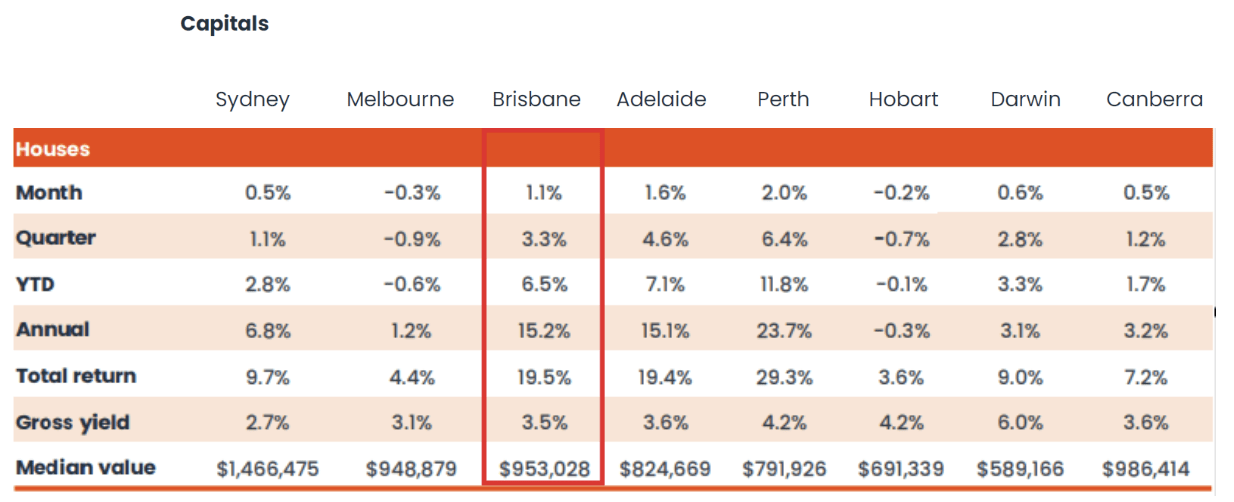
Source: CoreLogic
PropTrack data further validates that Brisbane house prices rose by 0.5 per cent in June, with annual growth standing at 13.67 per cent. Additionally, PropTrack data confirms that Brisbane ranks among the top three capital cities for both monthly and annual house price growth compared to all other capital cities across the country.

Source: PropTrack
Unit prices in Brisbane
Throughout June, unit values in Brisbane saw another very strong month of growth, rising by 1.8 per cent, following a 1.9 per cent increase in May. This shifts quarterly growth to 5.6 per cent (up from 5.3 per cent at the end of May) and annual growth in the unit segment to 18.8 per cent (up from 18.2 per cent at the end of May) for Brisbane. This confirms that the unit sector of the market continues to remain stronger than the housing sector on a monthly, quarterly, and annual basis.
The median value of a unit in Greater Brisbane is now $622,567, which is $7,138 more than last month. Over the last quarter, the median unit value in Brisbane has increased $34,774 and $110,305 over the last 12 months.

Source: CoreLogic
PropTrack data also confirms Brisbane median unit values increased 0.54 per cent over the month of June, putting annual growth at 16.82 per cent.
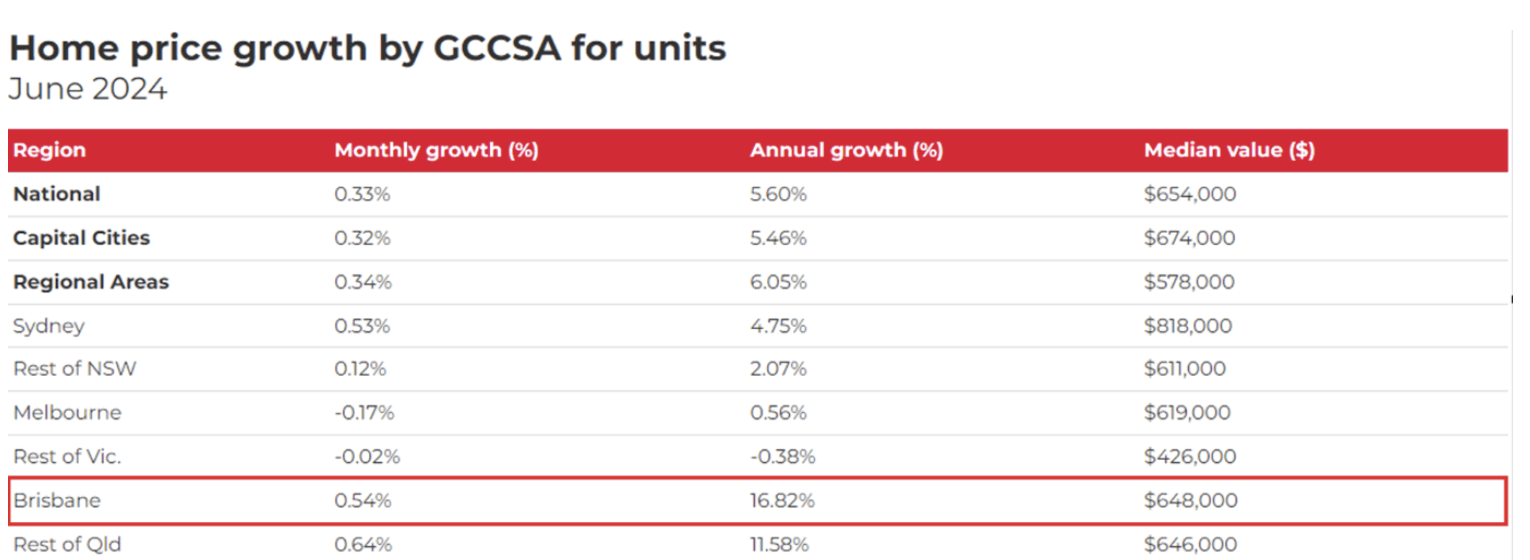
Source: PropTrack
The rental market in Brisbane
Vacancy rates in Brisbane remain steady at 1 per cent citywide, being unchanged for the last three months.
The annual change in house rents in Brisbane eased slightly to 7.3 per cent at the end of June, slightly lower than last month’s 8.2 per cent. Additionally, the annual change in unit rents in Brisbane is now at 8.5 per cent, a slight decrease from last month’s 9.6 per cent. Both segments of the rental market in Brisbane have now experienced a slowdown in rental growth over the last 12 months. While rental growth appears to be easing, rents are still growing well above long-term averages throughout Brisbane.
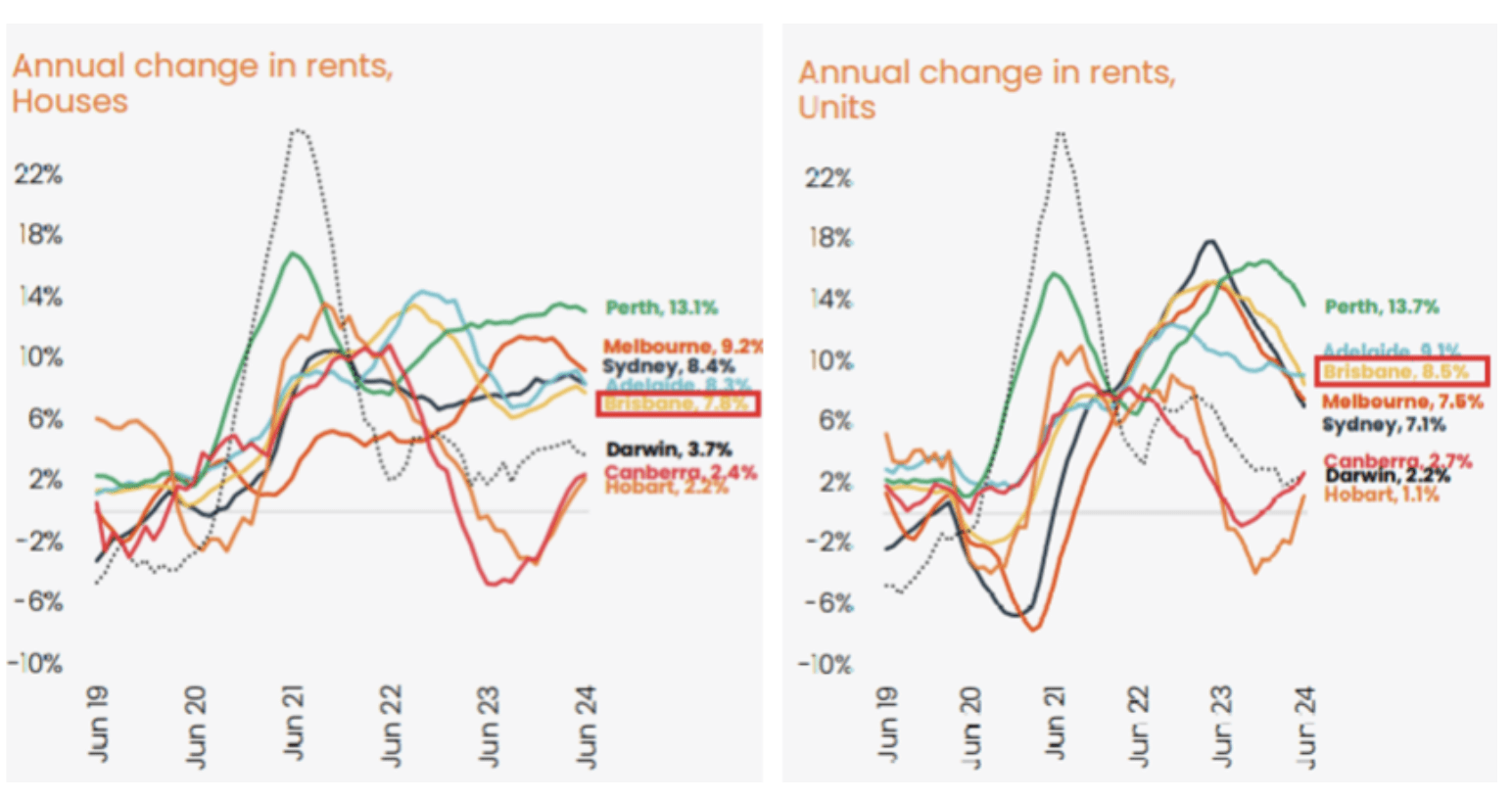
Source: CoreLogic
The gross yield for housing in Greater Brisbane currently stands at 3.5 per cent, easing slightly from last month, when it was 3.6 per cent. For units, the gross yield has decreased slightly again from 4.9 per cent to 4.8 per cent month-on-month. Gross rents in both segments of the market have declined throughout June as property values continue to rise at a faster pace than rental prices.
Summary
The Brisbane market remains robust and the outlook is also one of strong underlying fundamentals. There are a few drivers that are likely to continue to maintain strong demand for Brisbane property in the foreseeable future, at a time when the availability of listings remains well below long-term averages.
Firstly, stage three tax cuts will increase disposable incomes for most households, in turn increasing borrowing capacities for many households. These tax cuts have the potential to further inflate housing prices through stronger underlying demand and increased purchasing power.
Many are hoping that housing supply will lift to match strong demand, however per capita building completions and approvals are both at historic low levels. This discrepancy in price between existing and new properties is another challenge for new development of both houses and units.
While there is strong demand for new housing, construction costs have risen so much that in many parts of the country replacement costs are more expensive than what existing homes are selling for. For these reasons, the Brisbane market will remain undersupplied for some time into the future.
While the latest data from APRA for the March quarter shows mortgage arrears are rising, they appear to be contained. Some households may be starting to experience financial hardship due to rising mortgage costs and cost-of-living pressures, however the total mortgage arrears remain slightly lower than levels experienced before the onset of COVID-19.
For any mortgage holders who do need to sell, based on CoreLogic’s latest Pain and Gain Report, the outlook is positive. Adelaide and Brisbane were tied for the most profitable cities, with a loss-making sales rate of just 1.6 per cent of resales. In Brisbane, 98.4 per cent of resales achieved a nominal profit in the March quarter, confirming that even for those who do need to sell, it is probably that the proceeds received will cover any debt as well as likely deliver a return on investment.
In their Property Market Outlook for June 2024, PropTrack recently revised their home price forecasts for Brisbane to be higher than originally predicted. This revision lifted Brisbane’s 2024 annual growth expectations by 1 percentage point off strong demand and “exceptionally tight” housing supply so far this year. PropTrack stated this is “due to the strong price growth momentum in the Brisbane market, low volume of stock for sale, and the boost from income tax cuts from the middle of this year”.
Brisbane’s market is not slowing down any time soon. If you are in the market to buy, now is the time to do so given the momentum of price movement that is being experienced month-on-month. Brisbane remains a location with very strong underlying investment fundamentals, despite the recent price gains, and it is also an appealing location for home buyers seeking a lifestyle that is more relaxed, with warmer winter days than many other capital cities around our country.
Melinda Jennison is the managing director of Streamline Property Buyers, and president of the Real Estate Buyers Agents Association of Australia.



